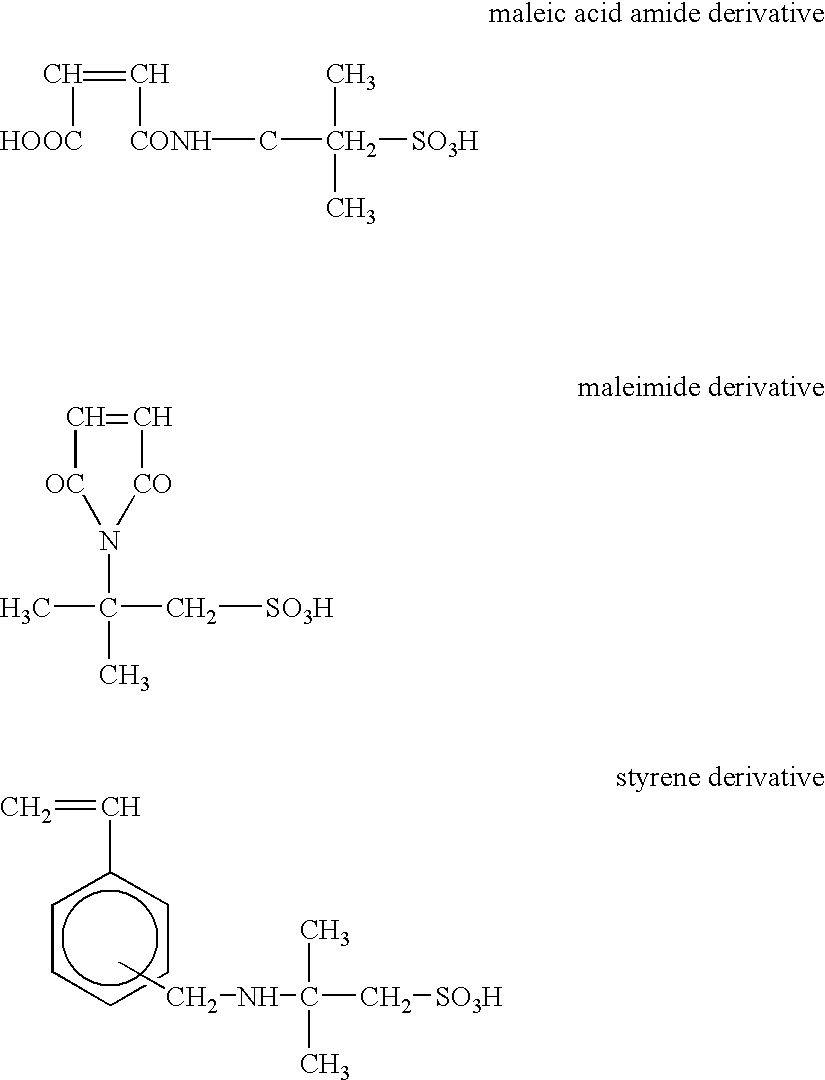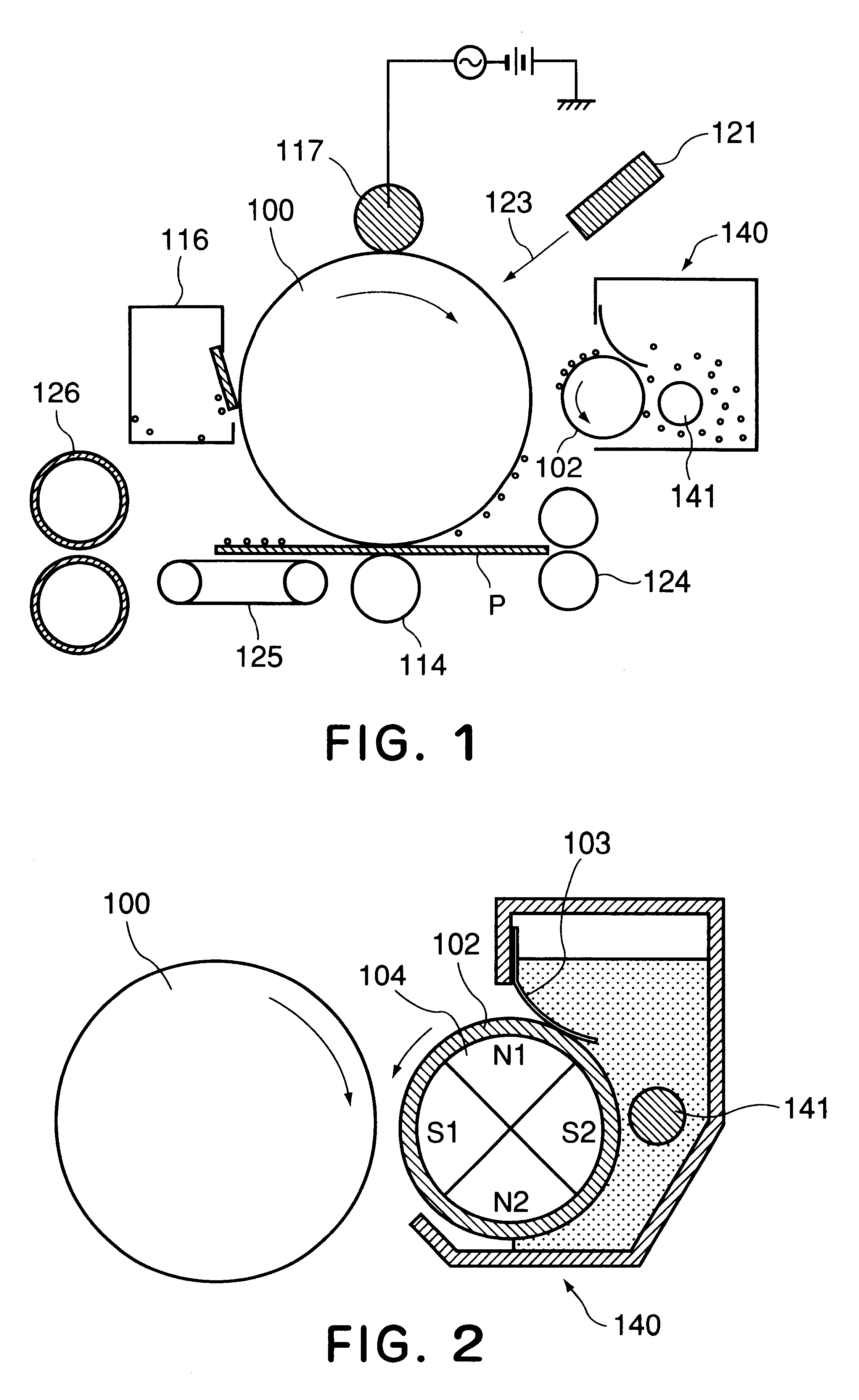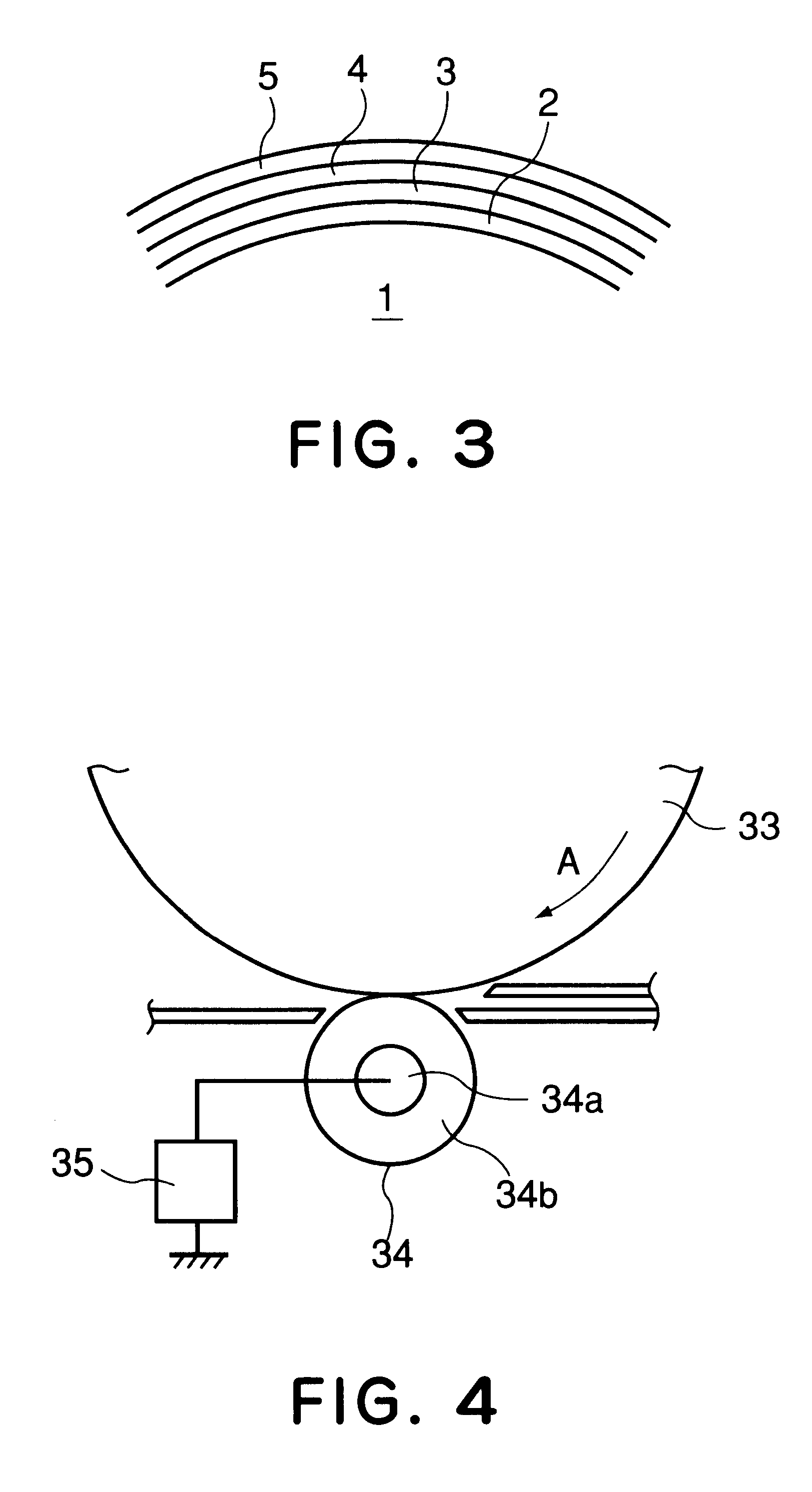However, even a magnetic toner containing a uniformly dispersed magnetic material as described and capable of realizing a satisfactorily
high resolution is liable to exhibit insufficient performances in continuous
image formation on a large number of sheets in an environment of high temperature /
high humidity or low
humidity.
For example, in the case of continuous formation of high-areal percentage images in a high temperature /
high humidity environment, the resolution is liable to be lowered to result in inferior
thin line reproducibility, and in the case of continuous formation of low-areal percentage images in a low
humidity environment, the resolution may be retained at a satisfactory level, but the density uniformity of a
solid image is liable to be impaired.
However, if the amount of the lower specific gravity fraction exceeds the range of the present invention, the liability of excessive charge leading to image defects such as
fog and scattering is substantially increased in a low
humidity environment.
In this case, however, because of the necessity of dispersing a polymerizable
monomer comprising ingredients including a polymerizable
monomer and
iron oxide having a substantial specific gravity difference therebetween in water under application of a shearing force, there is a possibility of non-uniform distribution of specific gravity and particle size of toner particles with respect to a weight-average particle size (D4, as measured by a Coulter counter described hereinafter) such that the lower-specific gravity fraction has a smaller weight-average particle size and the higher-specific gravity fraction has a larger weight-average particle size, respectively, compared with the weight-average particle size of the entire toner.
If the non-uniform distribution becomes substantial, the image qualities are liable to change substantially depending on changes in environmental conditions.
More specifically, in case where a magnetic toner containing
iron oxide exposed to the toner particle surfaces is used, charge leakage is caused by the exposed iron
oxide.
If charged toner particles lose their charge before the development to have a remarkably lower charge, the toner particles are liable to be attached to a non-
image area to result in image
fog.
On the other hand, if toner particles lose their charge after being transferred onto the photosensitive member, the toner particles are liable to fail in transfer onto a transfer member but remain on the photosensitive member, thus resulting in image defects, such as transfer dropout or hollow image.
Such a magnetic toner having a
magnetic powder-free shell region is liable to suffer from various difficulties as follows.
(i) The iron
oxide powder is localized at the inner portion of the toner particle, so that the liability of agglomeration of the iron
oxide powder is increased to result in a lower coloring power.
Accordingly, even if such a
surface layer is formed on toner particle surfaces, such toner particles are liable to cause melt-sticking or deformation when subjected to a stress during the toner production, so that the handing of toner particles during the toner production become complicated and the toner powdery characteristic is changed to adversely affect the electrophotographic performances and storage stability of the toner due to blocking of the toner particles.
(iii) Due to a soft superficial portion of the toner particles, the external additive particles are liable to be embedded at the toner particle surfaces, thereby deteriorating the continuous image forming performances of the toner.
The above-mentioned difficulties, such as a lower coloring power, inferior anti-blocking property and deterioration of continuous image forming performances, are liable to be enhanced when less than 50% by number of toner particles satisfy the relationship of D / C.ltoreq.0.02.
This is because particles having a circle-equivalent
diameter of below 3 .mu.m include a substantial amount of external additives present independently from the toner particles and can obstruct an
accurate estimation of circularity of toner particles.
The sphering and smoothening of pulverized toner particles cannot easily provide toner particles having an average circularity of at least 0.970 and requires an enormous
processing cost, with a possibility of a lowering in toner performances during the
processing.
This method however has a problem that the volatile matter peak can be masked by the
solvent peak.
More specifically, below 10 ppm, the organic volatile matter becomes excessively reduced to lower the attachment force between the toner particles and the external additive, thus resulting in separation of the external additive, which leads to a change in triboelectric charge to cause
image quality deterioration, such as a lower thin-line reproducibility, on
continuation of
image formation, particularly in a low humidity environment.
A toner having D4 below 3 .mu.m is liable to have a lower
transfer efficiency leading to an increased amount of transfer residual toner on the photosensitive member, thus making it difficult to suppress the abrasion of the photosensitive member and toner sticking in the contact charging step.
Further as the total area of the toner is increased, the flowability and stirability of the toner is lowered, so that the uniform charging of the individual toner particles becomes difficult to result in inferior
fog and transferability and cause image irregularity in addition to the abrasion and the melt-sticking.
On the other hand, at D4>10 .mu.m, a toner is liable to result in scattering in character or line images and fail in providing
high resolution.
Further, for a high-resolution apparatus, a toner having D4>8 .mu.m is liable to exhibit an inferior dot-reproducibility.
However, these effects cannot be expected at a satisfactory level if not combined with conditions that the
sulfur-containing resin is rich at the toner particle surfaces and the entire toner particle surfaces uniformly contact the triboelectrification member.
For example, indefinitely shaped toner particles, even if they contain such a
sulfur-containing resin, cannot exhibit a substantial increase in charge-transfer speed, since only projecting parts thereof contact the triboelectrification member.
Further, in a dispersion state where the
sulfur-containing resin is contained only inside the toner particles, a substantial improvement in chargeability cannot be expected due to insufficient contact with the triboelectrification member.
%, the dispersion stabilizer element is liable to remain in excess, to result in inferior fixability.
In excess of 50 mgKOH / g, the
resultant toner particles are liable to have distorted shapes showing a lower circularity, and a lower transferability, and the
release agent is exposed at the surface, thus showing a lower developing performance, especially when they are formed through
suspension polymerization.
in. If the content is below 0.01 wt. part, the good iron oxide dispersion state and the charge controlling function obtained thereby are scarce, and in excess of 20 wt. parts, the
resultant toner particles are liable to have a broad
particle size distribution leading to increased fog and cause a lowering in transferab
If Mw is below 2.times.10.sup.3, the resultant toner is liable to have an inferior anti-blocking property, and in excess of 1.times.10.sup.5, the
solubility thereof in the polymerizable
monomer at the time of toner production through the
polymerization process is lowered and the dispersibility of the
pigment is lowered to result in a toner having a lower coloring power.
If Tg is below 50.degree. C., the resultant toner is liable to have lower flowability and storage stability, and also a lower transferability.
If Tg is above 100.degree. C., the resultant toner is liable to exhibit a lower fixability, especially in the case of a high
image area percentage.
If the ratio E / A is below 0.0003, it becomes difficult to attain a sufficient charge-controlling function.
Iron oxide particles having an average particle size of below 0.1 .mu.m are not generally preferred because they are liable to provide a magnetic toner giving images which are somewhat tinted in red and insufficient in blackness with enhanced reddish tint in
halftone images.
Further, as the iron oxide particles are caused to have an increased surface area, the dispersibility thereof is lowered, and an inefficiently larger energy is consumed for the production.
Further, the coloring power of the iron oxide particles can be lowered to result in insufficient
image density in some cases.
Further, the wearing of the production apparatus can be promoted and the dispersion thereof is liable to become unstable.
Further, if particles of 0.1 .mu.m or smaller exceed 40% by number of total particles (having particle sizes of 0.03 .mu.m or larger), the iron oxide particles are liable to have a lower dispersibility because of an increased surface area, liable to form agglomerates in the toner to impair the toner chargeability, and are liable to have a difficulty in attaining a good balance between the
solid image uniformity and thin-line reproducibility.
Further, even if such minute particles are exposed to the toner particle surface, they do not substantially function as leakage sites lowering the chargeability of the toner particles.
On the other hand, if particles of 0.3 .mu.m or larger exceed 10% by number, the iron oxide particles are caused to have a lower coloring power, thus being liable to result in a lower
image density.
However, if an ordinary iron oxide is incorporated as a magnetic material in such a
polymerization toner, it is difficult to suppress the
exposure of iron oxide particles to the toner particle surfaces.
Further, because of a
strong interaction between the iron oxide and water during
polymerization toner production, it is difficult to obtain toner particles having an average circularity of 0.970 or higher.
The surface treatment of iron oxide particles with a hydrolyzing
coupling agent in an
aqueous medium does not necessitate the use of a gassifying
coupling agent, such as chlorosilanes or silazanes but allows the use of a high-
viscosity coupling agent which has been difficult to use because of liability of causing agglomeration of iron oxide particles when used in the conventional gaseous phase treatment, thus exhibiting a very remarkable hydrophobization effect.
In the above formula (II), if p is smaller than 2, the hydrophobization treatment may become easier, but it is difficult to impart a sufficient hydrophobicity, thus making it difficult to suppress the
exposure of the
magnetic powder to the toner particle surfaces.
On the other hand, if p is larger than 20, the hydrophobization effect is sufficient, but the coalescence of the
magnetic powder particles becomes frequent, so that it becomes difficult to sufficiently disperse the treated magnetic
powder particles in the toner, thus being liable to result in a toner exhibiting lower fog-prevention effect and transferability.
If q is larger than 3, the reactivity of the
silane coupling agent is lowered, so that it becomes difficult to effect sufficient hydrophobization.
If the toner has a
magnetization of below 10 Am.sup.2 / kg at a
magnetic field of 79.6 kA / m, it becomes difficult to convey the toner on the toner-carrying member, and toner ear formation on the toner-carrying member becomes unstable, thus failing to provide uniform charge to the toner.
As a result, image defects, such as fog,
image density irregularity and
recovery failure of transfer-residual toner are liable to be caused.
If the
magnetization exceeds 50 Am.sup.2 / kg, the toner particles are liable to have an increased magnetic agglomeratability, to result in remarkably lower flowability and transferability.
As a result, the transfer-residual toner is increased to be liable to result in lower
image quality.
Further, the increase in amount of magnetic material required for providing the
magnetization is liable to result in an inferior fixability.
As mentioned above, a toner having a weight-average particle size of at most 10 .mu.m can provide a very
high definition image, but such fine toner particles when transferred onto paper as a transfer-receiving material are liable to enter gaps between paper fibers, thus receiving insufficient
heat energy from the heat-fixation roller to cause low-temperature offset.
%, the long-term storability of the toner is lowered, and the dispersibility of other toner ingredients is lowered to result in inferior toner flowability and lower image forming performances.
Below 1 wt. part, the addition effect thereof is scarce, and above 20 wt. parts, the designing of various properties of the resultant polymerization toner becomes difficult.
The presence of a water-soluble salt however can obstruct the removal of the residual polymerizable monomer in the final stage of polymerization, so that it is advisable to exchange the
aqueous medium or effect desalting with
ion-exchange resin.
In case where the inorganic
fine powder has an average primary particle size larger than 80 nm, it becomes difficult to attain good toner flowability, so that the toner particles are liable to be charged non-uniformly, thus incurring difficulties, such as increased fog, a lower image density and lowering in continuous image forming performances, especially in a low humidity environment.
On the other hand, in case where the inorganic
fine powder has an average primary particle size of below 4 nm, the inorganic
fine powder particles are liable to have too strong an agglomeratability and thus form agglomerated secondary particles providing a broad particle size distribution which cannot be readily disintegrated.
As a result, the agglomerated toner particles are liable to damage the photosensitive member and the toner-carrying member, thus resulting in image defects.
Below 0.1 wt. part, the effect is scarce, and above 4.0 wt. parts, the resultant toner is caused to have inferior fixability.
If the inorganic fine powder added to the toner absorbs
moisture, the toner chargeability is liable to be remarkably lowered, thus resulting in lower developing performances and transferability.
An amount of below 5 wt. parts is insufficient for dissipating the active
hydrogen group on the inorganic fine particle surfaces.
On the other hand, at an amount in excess of 50 wt. parts, an excessive amount of the
silylation agent functions as a glue for agglomerating the inorganic fine particles to result in image defects.
Below 10 mm.sup.2 / s, the treated inorganic fine powder is liable to lack the stability and result in inferior images due to thermal and mechanical stresses.
Above 200,000 mm.sup.2 / s, a uniform treatment is liable to be difficult.
er. Too small an amount of
silicone oil cannot provide a sufficient hydrophobicity, and too large an amount also causes the agglomeration of the inorganic fine powd
 Login to View More
Login to View More 


